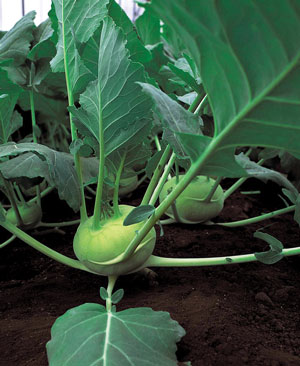 Purple and White Vienna kohlrabi is a heirloom blend.
Purple and White Vienna kohlrabi is a heirloom blend.
© National Garden Bureau/ngb.org
It may look like an alien from outer space, but kohlrabi actually comes from the ground and is related to cabbage, broccoli, mustards and kale, all members of the Brassica family.
Use of this vegetable dates to the Roman Empire and it has been popular fare in Europe for centuries. The odd-looking kohlrabi arrived in the United States in the 1920s, first grown in the perfect climate of California farm fields, where most of it is still grown commercially today.
Kohlrabi has green, white or purple skin and white flesh. The whole plant can be eaten raw or cooked. The taste of the bulb, actually a swollen stem, is described as a sweet radish; a cross between an artichoke and a potato; a broccoli stem, only more mild and a bit sweeter; a cucumber; an apple; or mild turnip. The leaves have a peppery flavor. Varieties to look for include: Quickstar F1 (very early), Konan F1 (crisp, juicy and sweet), Purple Vienna and Kolibri F1 have purple skin and white flesh.
 Quickstar kohlrabi forms uniform bulbs and is exceptionally early.
Quickstar kohlrabi forms uniform bulbs and is exceptionally early.
© National Garden Bureau/ngb.org
Sow seeds directly in the garden four to six weeks before the last frost in spring, or as soon as the soil can be worked. Pick a sunny spot with average soil and decent drainage. Sow seeds about ¼ inch deep, 10 to 12 seeds per foot. It takes about two weeks for seeds to germinate.
Follow spacing and thinning directions on the seed packet. You can eat the thinnings, by the way. Fertilize with one that's just for veggies according to label directions. Harvest after about 55 days, when the kohlrabi is 2-3 inch diameter. If it gets larger than a tennis ball, the bulb loses its flavor and becomes pithy and woody.
Once harvested, chop off the leaves for use in salads, soups or stir-fries. Peel the bulb and thinly slice it, drizzle with olive oil and sprinkle with sea salt for a salad or side dish. The bulb also can be used in stir-fries, soups, stews or roasted.
by Jo Ellen Meyers Sharp